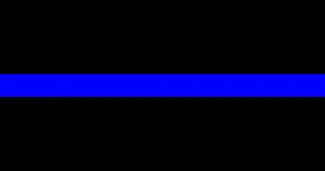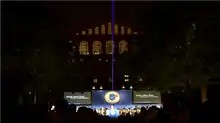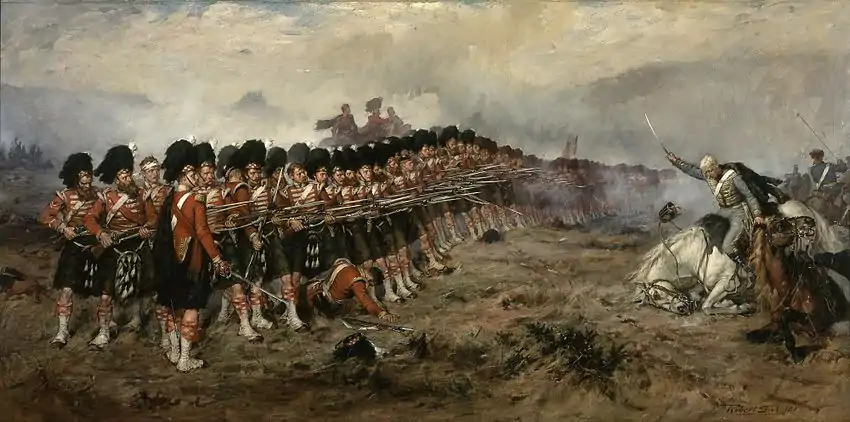Thin blue line
The "thin blue line" is a term that typically refers to the concept of the police as the line which keeps society from descending into violent chaos.[1] The "blue" in "thin blue line" refers to the blue color of the uniforms of many police departments.

The phrase originated as an allusion to the British infantry regiment The Thin Red Line during the Crimean War in 1854, wherein the regiment of Scottish Highlanders—wearing red uniforms—famously held off a Russian cavalry charge. Its use referring specifically to the police was popularized by Los Angeles Police Chief Bill Parker during the 1950s; author and police officer Joseph Wambaugh in the 1970s, by which time "thin blue line" was used across the United States;[2] and Errol Morris's documentary The Thin Blue Line (1988).[3]
History
The term is derived from the Thin Red Line, a formation of the 93rd Highland Regiment of Foot of the British Army at the Battle of Balaclava in 1854, in which the Scottish Highlanders stood their ground against a Russian cavalry charge.[2] This action was widely publicized by the press and recreated in artwork, becoming one of the most famous battles of the Crimean War. The name is now used for firefighters today.
In the book Lawtalk, James Clapp and Elizabeth Thornburg say the term spread to other professions, e.g. a "thin white line of bishops".[3][4]
An early known use of the phrase "thin blue line" is from a 1911 poem by Nels Dickmann Anderson, titled "The Thin Blue Line". In the poem, the phrase is used to refer to the United States Army, alluding both to the Thin Red Line and to the fact that US Army soldiers wore blue uniforms from the eighteenth century through the nineteenth century.[2][5]
It is unknown when the term was first used to refer to police. New York police commissioner Richard Enright used the phrase in 1922.[3] In the 1950s, Los Angeles Police Chief Bill Parker often used the term in speeches, and he also lent the phrase to the department-produced television show The Thin Blue Line.[6] Parker used the term "thin blue line" to further reinforce the role of the LAPD.[1] As Parker explained, the thin blue line, representing the LAPD, was the barrier between law and order and social and civil anarchy.[7]
The Oxford English Dictionary records its use in 1962 by The Sunday Times referring to police presence at an anti-nuclear demonstration.[8] The phrase is also documented in a 1965 pamphlet by the Massachusetts government, referring to its state police force, and in even earlier police reports of the NYPD. By the early 1970s, the term had spread to police departments across the United States.[2] Author and police officer Joseph Wambaugh helped to further popularize the phrase with his police novels throughout the 1970s and 1980s.[3]
The term was used for the title of Errol Morris's 1988 documentary film The Thin Blue Line about the murder of the Dallas Police officer Robert W. Wood.[2] Judge Don Metcalfe, who presided over the trial of Randall Adams, states in the film that prosecutor "Doug Mulder's final argument was one I'd never heard before: about the 'thin blue line' of police that separate the public from anarchy." The judge admitted to being deeply moved by the prosecutor's words, though the trial resulted in a wrongful conviction and death sentence.[9]
According to a 2018 law review article, "thin blue line" also refers to an unwritten code of silence used to cover up police misconduct, also known as the blue wall of silence,[10] a term dating back to 1978.[11]
Symbols and variations
The "Thin Blue Line" flag is all black, bearing a single horizontal blue stripe across its center. Variations of the flag, often using various national flags rendered in black and white with a blue line through the center, are seen below. The "Blue Lives Matter" movement was created in December 2014, after the homicides of NYPD officers Rafael Ramos and Wenjian Liu in Brooklyn, New York.[12]
The Punisher skull emblem has become popular within the Blue Lives Matter movement, with many companies producing decals, stickers, and T-shirts featuring the Punisher emblem colored with or alongside the thin blue line.[13][4] The creator of the Punisher, Gerry Conway, has criticized this usage, saying that police who use the symbol "are embracing an outlaw mentality" and "it's as offensive as putting a Confederate flag on a government building".[14] Conway has also responded by trying to "reclaim the logo" by selling t-shirts adorned with the Punisher logo and Black Lives Matter, with sales going directly to Black Lives Matter-related charities.[15]
Appearances and controversy

- In 2015, police officers in Sussex, England were told by their supervisors to remove a badge from their uniforms with a blue line across a union jack since it was not part of their official uniform. There was a concern that it could be seen as a political statement related to cutbacks in police forces.[19]
- In Chicago, in November 2016, counterprotesters carried the black and white US flag symbol to show support for police after a police shooting of Joshua Beal in opposition to another group of protesters who felt the shooting was unjust and racially motivated.[20]
- In Warwick, New York, the painting of a blue line down a roadway was protested by some citizens as being in opposition to the Black Lives Matter movement. The town has since painted the line red, white, and blue, the colors of the US flag.[21]
- In Riviera Beach, Florida, a group of police officers flew the thin blue line flags on their personal vehicles. They were ordered by their captain to remove the flags.[22]
- During the Unite the Right rally in Charlottesville in 2017, the thin blue line flag was flown alongside the Confederate battle flag[23][24] by demonstrators.[24]
- In 2017, Multnomah County Courthouse removed the flag after it gained notoriety with the Charlottesville demonstrators.[25]
- In July 2019, the "Thin Blue Line" American Flag was put up by residents of York, Maine, as a way to pay tribute to a local police officer who was shot and killed in the line of duty decades ago. Due to accusations of racism from members of the York Diversity Forum, Charlie Black, the son of fallen State Police Trooper Charles Black subsequently took the flag down.[26]
- In May 2020, officers of the SFPD were forbidden from wearing face masks (for disease protection against COVID-19) with "Thin Blue Line" symbols on the job. The SFPD chief of police, Bill Scott, stated that this decision was made "in consideration of concerns some community members have expressed that 'thin blue line' symbolism on some of our officers' face masks may be perceived as divisive or disrespectful".[27]
- On May 31, 2020, the Hamilton County Sheriff's Department in Cincinnati, Ohio flew the blue line flag in place of the American flag in response to the George Floyd protests. The department tweeted that the original flag had been stolen and the blue line flag flown as a replacement in honor of the Cincinnati Police Department officer shot during the unrest.[28]
- On June 1, 2020, the Middletown, Connecticut Police Chief, William McKenna, made a joint statement along with the mayor of the city, Ben Florsheim, stating that they would be removing the flag from public view at the Middletown Police Department. A change.org petition that garnered over 1,300 signatures for the flags to be removed in wake of the killing of George Floyd influenced the city to make the choice.[29]
- On July 30, 2020, Blue Lives Matter flags were removed from Hingham, Massachusetts fire trucks after days of controversy over whether the flags simply salute police officers or have a more divisive political message. Some townspeople had confused the flag with the genuine "Thin Blue Line" flag.[30][31]
Critics suggest that the "thin blue line" symbolism represents an "us versus them" mindset that heightens tensions between officers and citizens and negatively influences police-community interactions,[32] by setting police apart from society at large.[33]
See also
- Blue wall of silence
- The Thin Blue Lie, a television film about police brutality in Philadelphia under the mayorship of Frank Rizzo
- Militarization of police
References
- Wall, Tyler (2019). "The police invention of humanity: Notes on the "thin blue line"". Crime Media Culture. 16 (3): 319–336. doi:10.1177/1741659019873757. S2CID 204382721.
- Day, Meagan (14 July 2016). "The problem with the 'thin blue line?' Cops aren't the army". Timeline (Medium). Archived from the original on 2017-05-24.
- Chammah, Maurice; Aspinwall, Cary (June 9, 2020). "The Short, Fraught History of the 'Thin Blue Line' American Flag". Politico. Retrieved 10 June 2020.
- "The Short, Fraught History of the 'Thin Blue Line' American Flag". The Marshall Project. 2020-06-08. Retrieved 2021-01-13.
- Anderson, N. D. (1911). The Voice of the Infinite. Sherman, French. p. 6. Retrieved October 1, 2017.
thin blue line.
- Shaw, David (25 May 1992). "Chief Parker Molded LAPD Image--Then Came the '60s : Police: Press treated officers as heroes until social upheaval prompted skepticism and confrontation". Los Angeles Times.
- Lasley, J. (2012). Los Angeles Police Department Meltdown: The fall of the professional reform model of policing. Boca Raton, Florida: Taylor & Francis. pp. 1–26. ISBN 9781439899175..
- "thin". Oxford English Dictionary (Online ed.). Oxford University Press. Retrieved June 29, 2018. (Subscription or participating institution membership required.)
- "Thin Blue Line: Interview Gallery". Errol Morris. Retrieved 2016-12-13.
- Hodges, Ann C.; Pugh, Justin (June 2018). "Crossing the Thin Blue Line: Protecting Law Enforcement Officers Who Blow the Whistle" (PDF). UC Davis Law Review Online. 52 (1): 8. SSRN 3193264. Retrieved July 31, 2020.
- Walker, Charles C. (September 5, 1978). "Abuses". The Philadelphia Inquirer. Cheyney, Pennsylvania. Retrieved July 31, 2020.
- Dempsey, John S.; Forst, Linda S.; Carter, Steven B. (2018). An Introduction to Policing. Cengage Learning. p. 34. ISBN 9781337558754.
- "Chief removes Punisher emblem, 'Blue Lives Matter' from police cars after public reacts". Lexington Herald-Ledger.
- "Punisher Creator Gerry Conway: Cops Using the Skull Logo Are Like People Using the Confederate Flag". SyFy Wire.
- Punisher Co-Creator Gerry Conway Wants to Reclaim Iconic Skull Logo for Black Lives Matter - IGN, retrieved 2020-06-25
- "Nášivka "Tenká Modrá Linie" – Thin Blue Line". Krimi-Plzeň (in Czech). 14 January 2020.
- Arsalides, Mike (July 27, 2020). "Controversy surrounds a flag flying at the OPPA Barrie building". CTV News. Retrieved 10 September 2020.
- they’re wearing “thin blue line” flags now
- "Sussex PC told to remove union jack police charity badge". BBC News. 17 February 2015.
- Ludwig, Howard (November 20, 2016). "Three Groups of Protesters Come Face To Face in Mount Greenwood". DNAinfo. Archived from the original on June 21, 2018. Retrieved August 14, 2018.
- Bayne, Richard J. (December 6, 2016). "Blue line causes friction in Warwick". Times Herald-Record.
- Magnoli, Mike (March 14, 2017). "Thin Blue Line Flag controversy". WPEC.
- "Courthouse Removes Flag After White Supremacists Display It". U.S. News & World Report. Associated Press. August 25, 2017.
- Rossman, Sean (August 18, 2017). "'Thin Blue Line': What does an American flag with a blue line mean?". USA Today.
- Matsumoto, Samantha (August 25, 2017). "Ore. sheriff removes 'Thin Blue Line' flag from courthouse break room". The Oregonian. PoliceOne.
- "Son of slain Maine state trooper says it's time to move on after Thin Blue Line flag removed". Bangor Daily News. Retrieved 2019-08-26.
- Gearty, Robert (2020-05-03). "San Francisco police chief nixes officers' 'Thin Blue Line' coronavirus masks". Fox News. Retrieved 2020-05-31.
- McKenzie, Ian (2020-05-31). "Hamilton County Sheriff's Office Flew Blue Line Flag". Cincinnati Enquirer. Retrieved 2020-05-31.
- Salzo, Vincent (June 2, 2020). "'Thin Blue Line' Flags Taken Down At Middletown Police Department". Patch. Retrieved June 4, 2020.
- Smith, Tovia (July 31, 2020). "Thin Blue Line Flags Stir Controversy In Mass. Coastal Community". NPR. Retrieved July 31, 2020.
- Fox, Jeremy C. (July 30, 2020). "'Thin blue line' flags removed from Hingham fire trucks with help from Weymouth police". The Boston Globe.
- Kurtz, Don L.; Colburn, Alayna (2019). "Police Narratives as Allegories that Shape Police Culture and Behaviour". In Fleetwood, Jennifer; Presser, Lois; Sandberg, Sveinung; Ugelvik, Thomas (eds.). The Emerald Handbook of Narrative Criminology. Emerald Publishing. p. 330.
- Harris, David A. (2012). Failed Evidence: Why Law Enforcement Resists Science. New York University Press. p. 106.

.svg.png.webp)
.svg.png.webp)
.svg.png.webp)
.svg.png.webp)
.svg.png.webp)
.svg.png.webp)
.svg.png.webp)